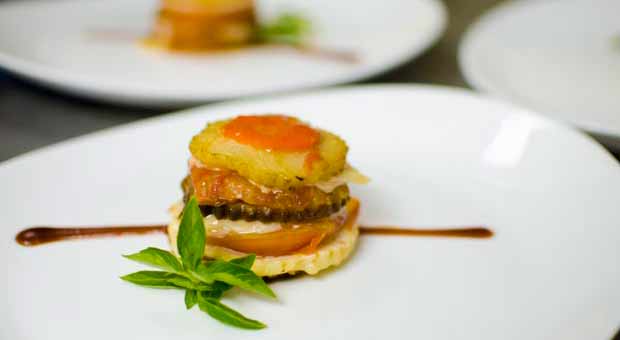By Cecilia Crespo
When the extravagant detective, Pepe Carvalho, a creation by Spanish writer Manuel Vázquez Montalbán, coined the term auteur cooking, he never imagined that in Havana, Cuba, would do such justice to this innovative way of cooking.
El Atelier, located in an old and fancy mansion in Vedado, is one of those restaurants that offer a wide symbiosis of culinary stylesincluding the characteristic deconstruction of auteur cooking: that of separating elements of a typical dish to cook it in an unusual way.
Beyond the glamour and gourmet charm that define this concept, the restaurant was practically forced to adopt that trend due to the need for substituting ingredients, innovating and supplementing some shortages when elaborating complex dishes of the international cuisine. With a successful combination of prices and quality, this place is in an enviable geographic situation: just a few meters from Havana’s Seawalk and the Meliá Cohíba Hotel.
According to Niurys Higuera Martínez, a whirl that turned into an entrepreneur, along with her brother, the place has hosted the family business for three centuries. It is a colonial house, one of the first built in Vedado which belonged to Senator Vázquez Bello, who also became president of the parliament. He turned this big house into a social place so the structure of the building is perfectly fitted for a restaurant.
This refined house was named after a known French word that means workshop and that’s precisely one of the objectives of its founders, to serve as a sui generis services workshop so that its workers learn and improve their trades in this sort of academy turned into a factory of exclusive gourmet food.
With great sensitivity, its owners and the chef gave free rein to creativity and boosted inventiveness and after three years work El Atelier is one of the favorite gastronomic spaces in the city. Ever since its foundation, the purpose of its staff was to make clients feel at home and encourage them to make suggestions to chef Enrique Edreira, who graduated from the Hotel Management and Tourism University of Sant Pol de Mar in Barcelona and is glad to comply with the customers’ demands. With his expertise, this artist has been able to turn his dishes into unique works that can only be enjoyed there.
As people walk into the broad and properly illuminated building, they get synesthetic feelings, they start perceiving smells and tastes until exotic and simple courses arrive at once. It is a sin not to try the stewed duck in orange juice, or the rabbit cooked in wine or the lamb in any of its variants that perk up the stomach just to reward it with an unforgettable cheesecake or a generous crème caramel that makes them remind their granny’s. It would also be a sacrilege not to try the lobster, already shelled, and dressed in a different sauce each day.
Even the New York Times echoed the delights served in this restaurant, which possesses one of the most spectacular terraces in Havana with an unforgettable view and marked personality. Romantic, intimate, nostalgic, El Atelier works as an unavoidable option to open or close the day, because it shuts its doors only when the last client leaves. Nothing is done randomly here. Everything has been studied; from the entrance, the arrangement of tables to the food, the service is a complete ritual. Customers leave the place with the impression of having been served in full.
Regular clients never find the place the same; nothing is in the same place they had seen it previously, decorations are in constant renovation as well as the menu. Niurys has made her best effort in reliving the past in her restaurant. She collects antiquities that range from typing machines to old telephones, which she shares with the customers.
There are baccaratand incrustation glasses, bohemian glass pieces, German porcelain sets, candelabra, etc. The house, as its owners refer to the place, is sophisticated and informal and diverse as well as the food they offer. It has been decorated eclectically, exquisitely, practically and aesthetically functional; it is in contrast with the menu, a handwritten menu given by waiters without uniforms. The walls impeccably painted are in contrast with raw brick walls under a colonial ceiling made of wood. Hanging from the walls there are canvases and photographs by contemporary plastic artists:Cirenaica Moreira, René Peña, Michel Mirabal, Alex Castro andEsterio Segura, among others.
It is a pleasure for the senses to enjoy the foods served in German porcelain sets from the 20’s. In this restaurant, the silver and German cutlery and sets are unique and rare pieces. The experience of taking a shot in a tiny blue glass carefully designed during the early 20th century and to crown with aCuban cigar or a simple cigarette one of the multicolored Murano ashtrays make customers feel special, and even more when sitting on a chair full of stories, that belonged to the generation of my great-great-grandfather.
Between courses client can meet the owners of the place, who are simple, enterprising, sensitiveand diaphanous people, so that they can understand that for them the restaurant is, rather than a business, a home, always willing to open its doors for a family dinner.
Images: Alain L Gutiérrez















